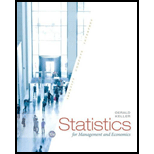
a:
Regression equation.
a:
Explanation of Solution
The general regression equation can be written as follows:
The term
Table 1 shows the processing of data as follows:
Table 1
| Sl | |||||
| 1 | -5 | 15 | 25 | 225 | -75 |
| 2 | -2 | 9 | 4 | 81 | -18 |
| 3 | 0 | 7 | 0 | 49 | 0 |
| 4 | 3 | 6 | 9 | 36 | 18 |
| 5 | 4 | 4 | 16 | 16 | 16 |
| 6 | 7 | 1 | 49 | 1 | 7 |
| Total | 7 | 42 | 103 | 408 | -52 |
Standard deviation
Standard deviation is -202.2.
The variance of x
The variance of x is 18.97.
The value of coefficient ( b1) can be calculated as follows:
The value of b1 is -1.065.
The average value
The average value of x is 1.167.
The average value
The average value of x is 7.
Intercept b0 can be calculated as follows:
The intercept value is 8.253.
Thus, the regression equation is given below:
b:
The predicted value of y.
b:
Explanation of Solution
The estimated value of y
Table 2 shows the predicted value of x that is obtained using the regression equation with different levels of x values as follows:
Table 2
| Sl | ||
| 1 | -5 | 13.58 |
| 2 | -2 | 10.38 |
| 3 | 0 | 8.253 |
| 4 | 3 | 5.058 |
| 5 | 4 | 3.993 |
| 6 | 7 | 0.758 |
c:
Calculate the residual.
c:
Explanation of Solution
The value of residual
Table 3 shows the residual value that is obtained using Equation (1) as follows:
Table 3
| Sl | |||
| 1 | -5 | 13.58 | 1.42 |
| 2 | -2 | 10.38 | -1.38 |
| 3 | 0 | 8.253 | -1.253 |
| 4 | 3 | 5.058 | 0.942 |
| 5 | 4 | 3.993 | 0.007 |
| 6 | 7 | 0.758 | 0.202 |
d:
Calculate the standardized residual.
d:
Explanation of Solution
The variance of y
The variance of y is 22.8.
Error sum of square (SSE) can be calculated as follows:
Error sum of square is 6.451.
The value of
The value of
The value of standardized residual (se) can be calculated using the below equation:
Table 5 shows the standardized residual value that is obtained using Equation (2) as follows:
Table 5
| Sl | se | |||
| 1 | -5 | 13.58 | 1.42 | 1.18 |
| 2 | -2 | 10.38 | -1.38 | -1.087 |
| 3 | 0 | 8.253 | -1.253 | -0.987 |
| 4 | 3 | 5.058 | 0.942 | 0.742 |
| 5 | 4 | 3.993 | 0.007 | 0.0055 |
| 6 | 7 | 0.758 | 0.202 | 0.159 |
e:
Identification of outliers.
e:
Explanation of Solution
From the above calculations, it is known that there are no outliers.
Want to see more full solutions like this?
Chapter 16 Solutions
Statistics for Management and Economics
- PART II: Multipart Problems wood or solem of triflussd aidi 1. Assume that a society has a polluting industry comprising two firms, where the industry-level marginal abatement cost curve is given by: MAC = 24 - ()E and the marginal damage function is given by: MDF = 2E. What is the efficient level of emissions? b. What constant per-unit emissions tax could achieve the efficient emissions level? points) c. What is the net benefit to society of moving from the unregulated emissions level to the efficient level? In response to industry complaints about the costs of the tax, a cap-and-trade program is proposed. The marginal abatement cost curves for the two firms are given by: MAC=24-E and MAC2 = 24-2E2. d. How could a cap-and-trade program that achieves the same level of emissions as the tax be designed to reduce the costs of regulation to the two firms?arrow_forwardOnly #4 please, Use a graph please if needed to help provearrow_forwarda-carrow_forward
- For these questions, you must state "true," "false," or "uncertain" and argue your case (roughly 3 to 5 sentences). When appropriate, the use of graphs will make for stronger answers. Credit will depend entirely on the quality of your explanation. 1. If the industry facing regulation for its pollutant emissions has a lot of political capital, direct regulatory intervention will be more viable than an emissions tax to address this market failure. 2. A stated-preference method will provide a measure of the value of Komodo dragons that is more accurate than the value estimated through application of the travel cost model to visitation data for Komodo National Park in Indonesia. 3. A correlation between community demographics and the present location of polluting facilities is sufficient to claim a violation of distributive justice. olsvrc Q 4. When the damages from pollution are uncertain, a price-based mechanism is best equipped to manage the costs of the regulator's imperfect…arrow_forwardFor environmental economics, question number 2 only please-- thank you!arrow_forwardFor these questions, you must state "true," "false," or "uncertain" and argue your case (roughly 3 to 5 sentences). When appropriate, the use of graphs will make for stronger answers. Credit will depend entirely on the quality of your explanation. 1. If the industry facing regulation for its pollutant emissions has a lot of political capital, direct regulatory intervention will be more viable than an emissions tax to address this market failure. cullog iba linevoz ve bubivorearrow_forward
- Exercise 3 The production function of a firm is described by the following equation Q=10,000-3L2 where L stands for the units of labour. a) Draw a graph for this equation. Use the quantity produced in the y-axis, and the units of labour in the x-axis. b) What is the maximum production level? c) How many units of labour are needed at that point? d) Provide one reference with you answer.arrow_forwardExercise 1 Consider the market supply curve which passes through the intercept and from which the market equilibrium data is known, this is, the price and quantity of equilibrium PE=50 and QE=2000. Considering those two points, find the equation of the supply. Draw a graph of this line. Provide one reference with your answer. Exercise 2 Considering the previous supply line, determine if the following demand function corresponds to the market demand equilibrium stated above. QD=3000-2p.arrow_forwardConsider the market supply curve which passes through the intercept and from which the marketequilibrium data is known, this is, the price and quantity of equilibrium PE=50 and QE=2000.a. Considering those two points, find the equation of the supply. b. Draw a graph of this line.arrow_forward
 Managerial Economics: Applications, Strategies an...EconomicsISBN:9781305506381Author:James R. McGuigan, R. Charles Moyer, Frederick H.deB. HarrisPublisher:Cengage Learning
Managerial Economics: Applications, Strategies an...EconomicsISBN:9781305506381Author:James R. McGuigan, R. Charles Moyer, Frederick H.deB. HarrisPublisher:Cengage Learning








